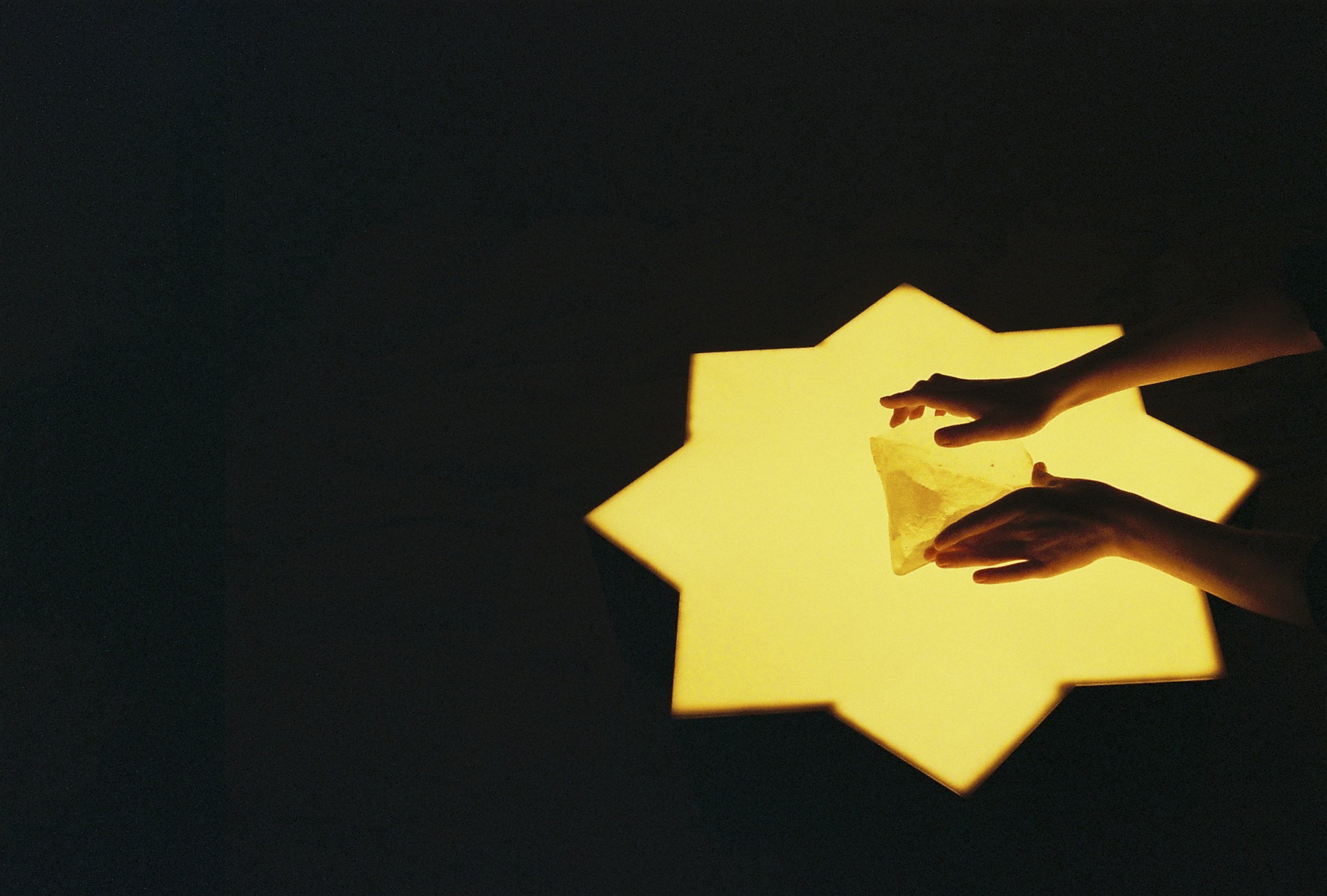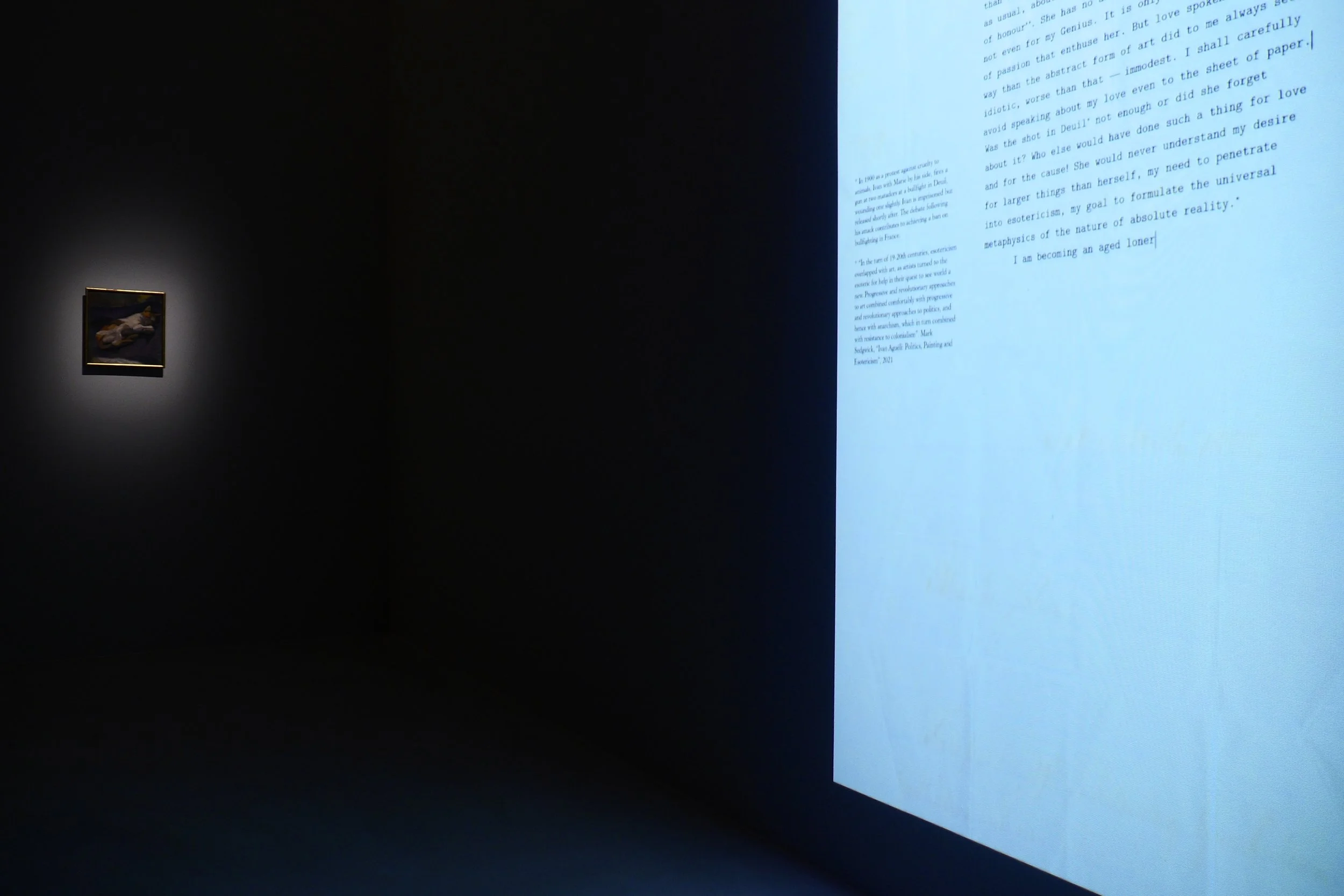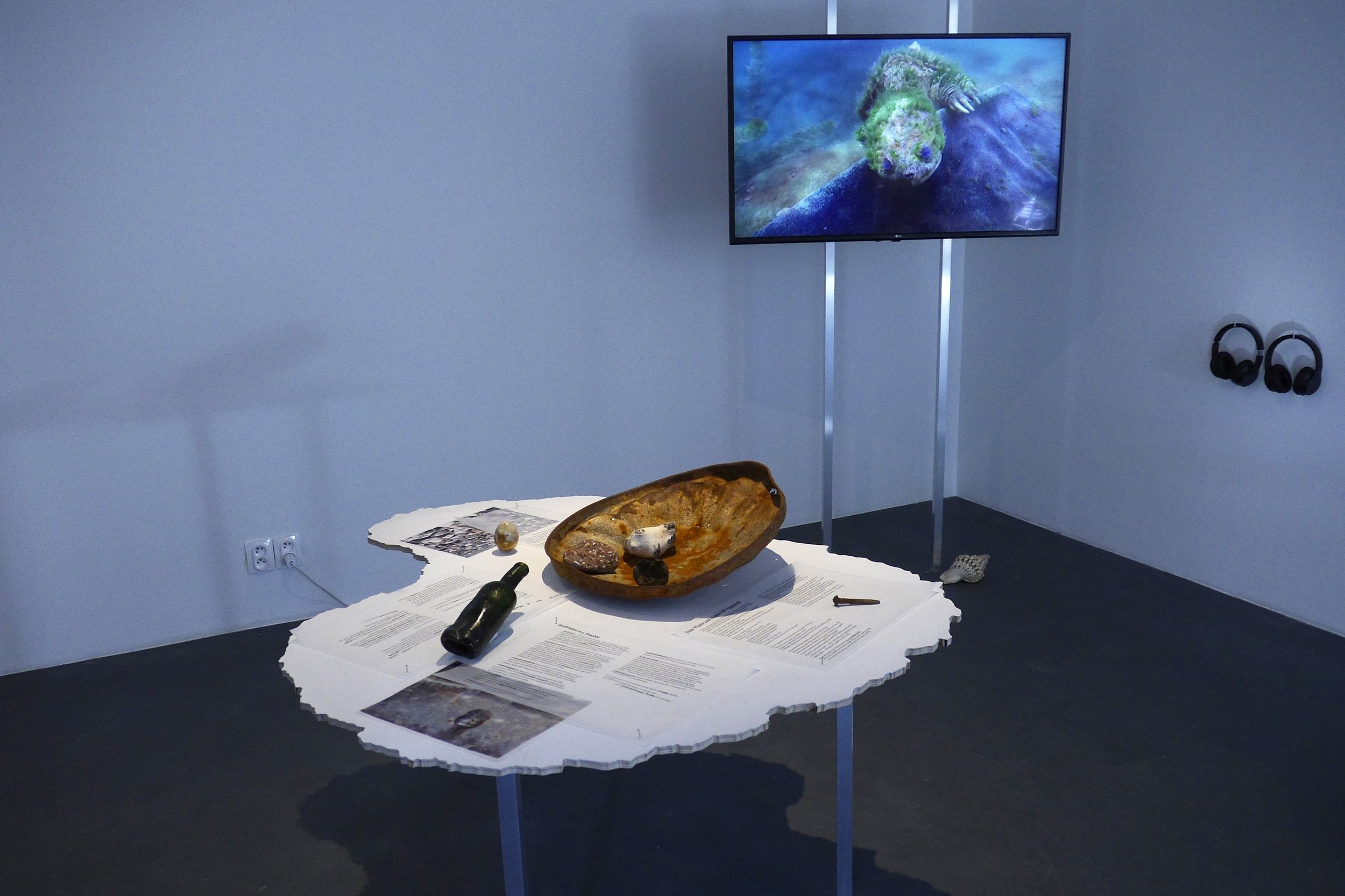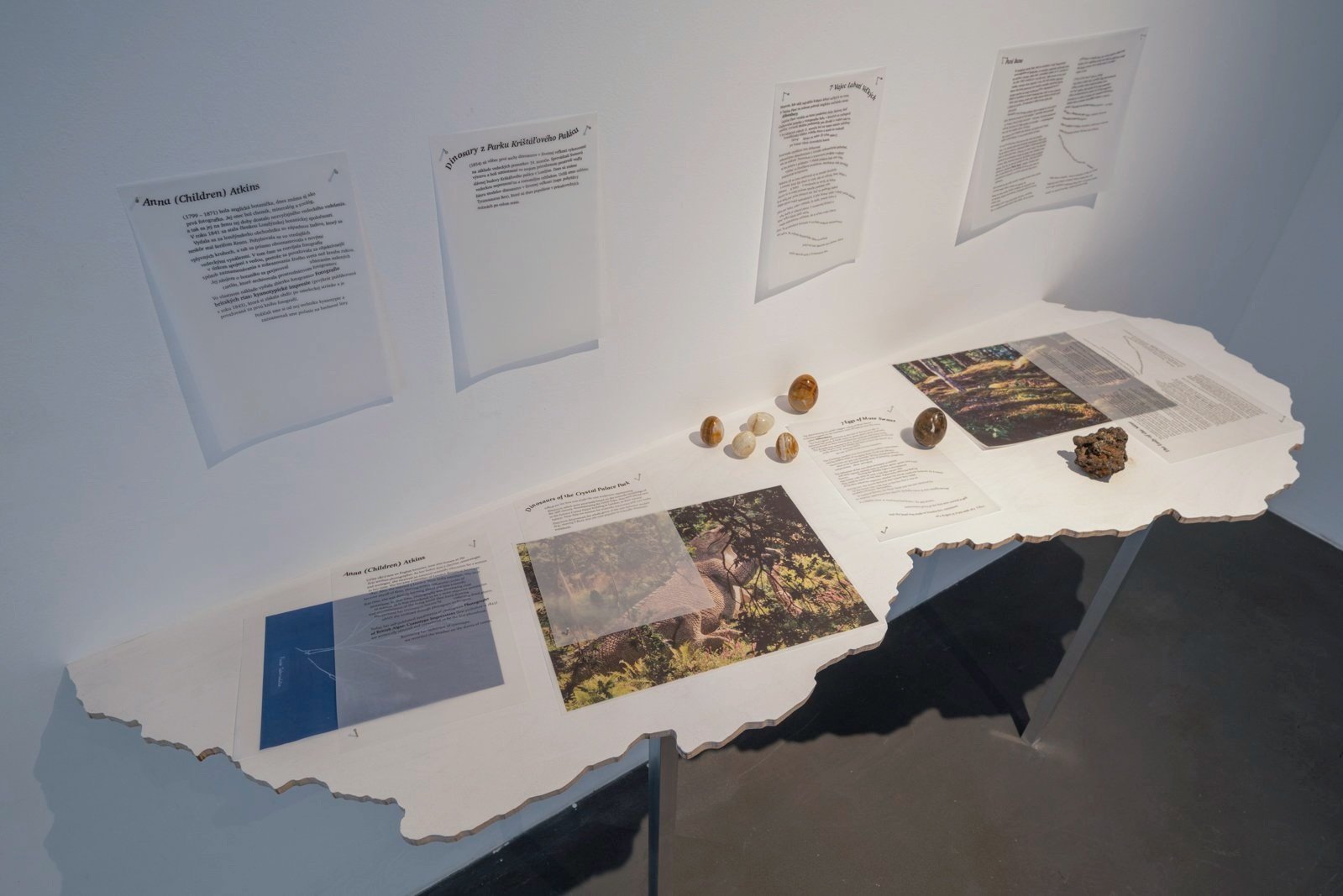installations
SERPENTINE SPINE
SOLO SHOW, 2023
Västerås Art Museum, Västerås
Based on two years of wandering in Sweden, Paris, Brussels, and roaming through the personal letters of Ivan Aguéli (1869-1917), Serpentine Spine was envisioned as an intimate encounter between Goda Palekaitė and the historical character. Through new works of language, glass and light, she attempted to grasp the mystical landscape in which the work and life of a nomad artist unfolds, in the past as well as today. Ivan Aguéli, born Johan Gustaf Agelii and later also known as Abdalhadi Aqhili, was a Swedish artist, writer and traveller. He lived a multifaceted and controversial life, periodically in France, Egypt, Ceylon (Sri Lanka) and India, embodying everything from religious scholar, art theorist, linguist, writer, journalist to anarchist, Sufi and an orientalist. As a nomad and artist herself, Goda feels an affinity with Aguéli and uses language and lighting installations to shed new light on his enigmatic body of work. She is interested in his intentions, desires, fetishes, and obsessions, recognizing in him aspects of herself.
The title of the exhibition, Serpentine Spine, alludes to scoliosis, an abnormal curvature of the spine, but also to backbone in the sense of willpower, strength, and balance in life. Palekaitė’s own condition of scoliosis made her question consciousness both in her body and in her practice. Perhaps it was her serpentine spine that led to her becoming an artist.
Film Swallower of Shades was screened as part of the exhibition, created in collaboration with Graham Kelly
Production: with assistance of Paloma Bouhana, Jesse Magee, Roxane Vandenreyt and Adomas Palekas
Serpentine Spine was a result of Palekaitė’s 2021-2022 residency at Art Lab Gnesta and Västerås Konstmuseum, supported by Nordic Cultural Fund
War Machines Based on the Dreams of the Enemies
GODA PALEKAITĖ & ADOMAS PALEKAS 2023
Kaunas Artists House, group exhibition In the beginning was the deed!
Curated by Edgaras Gerasimovičius & Vaida Stepanovaitė
War Machines Based on the Dreams of the Enemies is a sound installation, conceived collaboratively by a sister who wrote the scrip and and a brother who created the sound. It addresses the history of anarchism and the potential of thinking across ecology, economy and dreamhunting. Based on Goda’s and Adomas’ long-term research on classical anarchism and two performances that they had collaboratively created before (Bakunin and How to Infuriate a Historian), this 4 channel sound installation pierced through the building of Kaunas Artists House, and could be perceived as a never-ending conversation, vibrating with hope for ecological futures.
anthropomorphic trouble
GODA PALEKAITĖ & ADRIJANA GVOZDENOVIĆ 2021
Whitechapel Gallery in partnership with Delfina Foundation, London
Tranzit Bratislava as part of a group show I as it, or stones that vibrate, 2022
Curated by Arts Catalyst
Acknowledging the Earth as a historical character, learning from cosmologies and ecologies, and acting as amateur storytellers, Goda Palekaitė and Adrijana Gvozdenović’s Anthropomorphic Trouble traces their journey from their trouble, from incomprehensibility, through a landscape of associative thinking. The research started in their heads situated in Brussels, later travelled to places like the Jurassic coastline and Abbotsbury Swannery in Dorset, Arts Catalyst’s office in Sheffield, Nikola Tesla’s museum in Belgrade, at Delfina Foundation and Whitechapel gallery in London, various museums of natural history, zoos and aquariums throughout Europe, a mammoth grave in rural Serbia, and the Montenegrin mountains. The journey is inspired by three historical women: Mary Anning (1799-1847), a self-taught pioneer of palaeontology who discovered the first intact skeletons of dinosaurs at the age of 12; Anna Atkins (1799-1871), a botanist who worked with the cyanotype technique to collect and archive British algae, developing what is today known as the first book of photography; and Margaret Cavendish (1623-1673), a feminist avant-garde science-fiction writer and post-humanist philosopher from the Baroque era. The project was first presented as an installation, film, publication and performance at Whitechapel Gallery in London. Later, in a group exhibition at Tranzit Bratislava, it was reshaped in its new iteration, sharing research, stories, artefacts and artworks within a spatial installation.
Photo: Katarzyna Perlak, Goda Palekaitė and Adam Šakový
The Strongest Muscle in the Human Body is the Tongue
SOLO SHOW, 2021
Editorial in Vilnius and Kunsthal Gent in Ghent curated by Valerio Del Baglivo
There is a common misbelief that the strongest muscle in the human body is the tongue. Anatomically speaking, it is a proven falsehood. Yet with this show, Palekaitė proposes that, poetically speaking, it is more than true. The project talks about the power of speaking and writing in relation to the body and sexuality in the context of marginalised history. This time, Palekaitė speaks through women’s tongues — historic and contemporary female writers, mystics and saints. It can be seen as her tactic to speak through the voices of others in order to disseminate her own. In The Strongest Muscle in the Human Body is the Tongue, historical accounts are merged with ‘unreliable’ material (or the leftovers of history, such as dreams, rumours and opinions), as well as with fiction, and the artist’s own autobiographical testimonies. Working against the faith in authentic creativity and originality, Palekaitė welcomes historical characters on her inner journeys, as they welcome her on theirs, and so the intimacy with history can emerge. The project presents new works: the film I Write While Disappearing, the text installation The Blazing World, the sculpture First Class Relic, and the previously shown film Biographic Disobedience. Historical accounts are merged with ‘unreliable’ material, fiction, and the artist’s own autobiographical testimonies.
Photo: Ugnius Gelguda and Tomas Uyttendaele
liminal minds
SOLO SHOW, 2019
Konstepidemin Gallery in Gothenburg as part of GIBCA Extended (Göteborg International Biennial for Contemporary Art)
Atletika in Vilnius as part of the group show Living Ornament curated by Yates Norton, 2020
With her texts, installations and visual work, Goda Palekaitė invites to enter into the liminal minds of two historical figures, and perceive them as powerful critical thinkers who operated ahead of their times. The first man is Sweden’s underestimated futurist, an interdisciplinary scientist, theologian, mystic and medium, Emanuel Swedenborg (1688-1772); the second – French anthropologist and surrealist writer Michel Leiris (1901-1990). Both went through mystical transformative phases saturated with intense dreams, visions, psychosis and phantasies, and both documented them. While Swedenborg performed a radical critique of Western science and Christianity, Leiris’ account was central for the shift from colonialist to postcolonialist mindset. In this exhibition Palekaitė presents new light, sculpture and video intallations.
Photos: Goda Palekaitė & Laurynas Skeisgiela
































